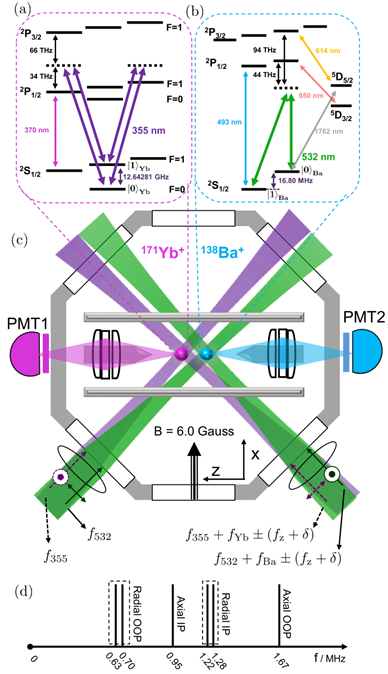The First Loophole-Free Test of Quantum Contextuality with Two Species of Atomic Ions
2022/02/16
Recently, Professor Kihwan Kim, assistant researchers Pengfei Wang and Jing-Ning Zhang from BAQIS, in cooperation with Tsinghua University, University de Seville and Southern University of Science and Technology, have experimentally demonstrated the first loophole-free quantum contextuality test. The work titled with "Significant loophole-free test of Kochen-Specker contextuality using two species of atomic ions" was published in Science Advances on February 9th.
Quantum contextuality reveals the fundamental differences between quantum and classical systems. In our daily classical world, when we measure observables and repeat the measurements in any order or at any times, the output results are always the same. Therefore, we naturally assume that the measured system has preexisting values, which are revealed by every measurement and persist after the measurements. However, this assumption fails in quantum mechanics. Quantum systems can produce measurement results that do not disturb each other and yield the same result when repeated, but their correlations of the measurements cannot be explained by the assumption of preexisting intrinsic values. This phenomenon has been suggested by Kochen, Specker and Bell in 1960, which resulted in the Bell-Kochen-Specker theorem of quantum contextuality in quantum mechanics and is behind the power of quantum computers to outperform classical computers.
But it has been a long-standing question how to experimentally test the quantum contextuality without “loopholes”, that provide falsely correct quantum mechanical results due to experimental imperfections. Recently, without major loopholes, a few experimental violations of Bell’s test, similar to quantum contextuality test with the requirement of space-like separated sub-systems, have been demonstrated. However, many quantum systems including quantum computers are difficult to be large enough to contain space-likely separated sub-components. In such cases, how can we guarantee that the system is operating in the quantum regime and governed by the principle of quantum mechanics? The quantum contextuality test can provide a solution. The contextual correlations have been observed in experiments with photons, neutrons, ions, molecular nuclear spins, superconducting systems, and nuclear spins. But it was still lacking the loophole-free test.
In the paper, an experimental evidence for a loophole-free test of the quantum contextuality is presented by using composite systems but without space-like separation. We perform the experiments with two-species of atomic ions and ensure the conditions of ideal measurement by performing the repeated measurements on both Yb and Ba ions that do not interfere each other without any missing data. The experiment setup is shown in Fig. 1. All the experimental results agree with the predictions of quantum mechanics by over 15 standard deviations.

Fig. 1 Hybrid two-ion experimental setup
In detail, there are two major loopholes in the quantum contextuality test, the detection loophole and ideal measurement loophole that can be decomposed with sharpness and compatibility loophole. The detection and sharpness loopholes are closed by adopting a hybrid two-ion system and highly efficient fluorescence measurements offering a detection efficiency of 100% and a measurement repeatability >98%. The compatibility loophole is closed by targeting correlations between observables for two different ions in a Paul trap, a 171Yb+ ion and a 138Ba+ ion, chosen so measurements on each ion use different operation laser wavelengths, fluorescence wavelengths, and detectors. As shown in Fig. 2, the initial entangle state for the contextuality test is prepared by a MΦlmer-SΦrensen (M-S) gate. The experimental results show a violation of the bound for the most adversarial noncontextual models.

Fig. 2 Evolution of the M-S interaction and oscillation of parity signal
Other than the importance for fundamental research, this work also has direct implications to quantum algorithms and protocols running on devices where the assumption of locality cannot be made, as it is the case of quantum computers. These devices are not large enough to allow for spacelike related events that justify the assumption of locality. There, the possibility of producing loophole-free contextual correlations for sharp measurements allows, without relying on locality, for testing whether a claimed quantum computer is truly quantum, characterizing quantum systems, self-testing quantum random number generation, and blind quantum computation, among other applications.
"An experiment closing all significant loopholes shows that nature is not non-contextual for the first time", Pengfei Wang describes this work, "It is an important progress in the fundamental research and will help us to know more about the quantum world.”
Reference: Wang, Pengfei and Zhang, Junhua and Luan, Chun-Yang and Um, Mark and Wang, Ye and Qiao, Mu and Xie, Tian and Zhang, Jing-Ning and Cabello, Adán and Kim, Kihwan (2022) Significant loophole-free test of Kochen-Specker contextuality using two species of atomic ions. Science Advances, 8 (6).
 中文
中文 Email
Email QCloud
QCloud Log in
Log in
